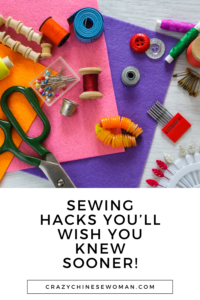Here are some essential sewing tips and techniques tailored for beginners to help you get started smoothly and improve your skills over time:

1. Master the Basics of Threading
- Tip: Learn to thread your sewing machine correctly, including threading the bobbin and needle. Misthreading can cause skipped stitches or machine jams.
- Trick: Follow your machine’s manual closely and practice threading several times to build confidence. Use a bright-colored thread to see if it’s correctly in place.
2. Use the Right Needle and Thread for Each Project
- Tip: Different fabrics require specific needles and thread. For instance, use ballpoint needles for knits, denim needles for thick fabrics, and fine needles for delicate fabrics.
- Trick: Keep a needle chart handy to help you choose the right needle and thread combination. Mark needles with labels if they’re used or designated for specific projects.
3. Practice Straight Stitching on Scraps
- Tip: Start by practicing your stitching on fabric scraps. Straight, even stitches are the foundation of good sewing.
- Trick: Use lined paper as a practice guide! Place the paper under the needle and follow the lines to get a feel for straight stitching without fabric shifting.
4. Learn to Use the Reverse Stitch
- Tip: Use the reverse stitch (backstitch) at the beginning and end of your seams to lock them in place, preventing unraveling.
- Trick: Practice doing a few stitches forward, then a few back to secure, before stitching the full seam to keep things tidy and strong.
5. Iron Seams and Fabric Before and After Sewing
- Tip: Pressing fabric before sewing helps you achieve smooth, accurate seams, and pressing seams open afterward creates a professional finish.
- Trick: Use a pressing cloth for delicate fabrics to prevent scorching, and always iron along the grain of the fabric to avoid stretching.
6. Use Pins or Clips to Hold Fabric in Place
- Tip: Secure your fabric with pins or clips to avoid slippage and uneven seams.
- Trick: For thick fabrics, use binder clips instead of pins to hold layers together without creating holes. Place pins perpendicular to the seam line so you can sew right over them without removing.
7. Know Your Seam Allowance
- Tip: Most patterns have a 5/8” seam allowance, but always double-check. Maintain this allowance consistently for properly fitting pieces.
- Trick: Place a piece of painter’s tape on your machine’s throat plate as a guide to keep your seam allowances even.
8. Test Your Stitch Settings
- Tip: Always test your stitch length and width on fabric scraps before starting your project to ensure your settings suit the material.
- Trick: For stretch fabrics, use a zigzag stitch to maintain fabric elasticity, and adjust the stitch length for different thicknesses.
9. Finish Your Seams for Durability
- Tip: Finished seams (like zigzagging or serging edges) prevent fraying and add durability to your project.
- Trick: If you don’t have a serger, use a zigzag stitch along the seam edges to mimic the effect and prevent fraying on woven fabrics.
10. Practice Sewing Curves and Corners
- Tip: Curves and corners can be tricky, but practicing helps. Go slow and pivot at corners for sharp, accurate angles.
- Trick: For curves, lightly draw the curve on the fabric with tailor’s chalk to follow along easily. For corners, stop with the needle down, lift the presser foot, turn the fabric, and continue sewing.
11. Learn Basic Hemming Techniques
- Tip: Hemming is essential for finishing garment edges, curtains, and other projects. Master a simple double-fold hem for a clean edge.
- Trick: Use hem tape for tricky fabrics to keep hems in place while sewing, and press with an iron to get a sharp crease before stitching.
12. Use Basting Stitches for Temporary Holds
- Tip: Basting stitches are long, temporary stitches used to hold layers in place for fitting or adjustments.
- Trick: Use a contrasting color for basting stitches so they’re easy to see and remove once permanent stitching is complete.
13. Invest in Basic Sewing Tools
- Tip: Have sharp fabric scissors, a seam ripper, pins, and a measuring tape on hand for accurate sewing.
- Trick: Dedicate scissors to fabric only. Cutting paper dulls blades quickly, so use a different pair for paper or patterns.
14. Start with Simple Patterns
- Tip: Start with beginner-friendly patterns, like a tote bag or pillowcase, before advancing to more complex garments.
- Trick: Patterns with straight seams and minimal pieces will help you practice without overwhelming details.
15. Don’t Be Afraid to Use the Seam Ripper
- Tip: Mistakes are common in sewing, especially when you’re starting. Seam rippers are there to help undo stitches cleanly without damaging fabric.
- Trick: Go slow when ripping seams. Rushing can cause fabric tears, so gently glide the ripper along the stitches for a smooth removal.
These tips will help beginners build confidence and develop foundational skills. Over time, these practices will become second nature, allowing you to take on more advanced sewing projects with ease. Let me know if you’d like more tips on any specific sewing topic!